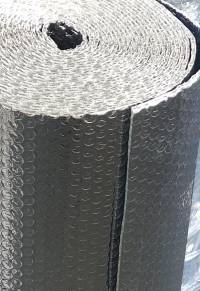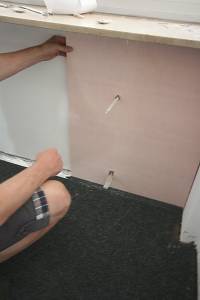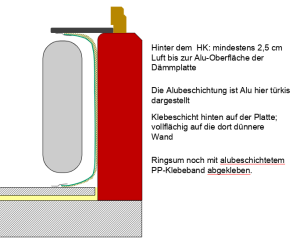Insulating radiator niches
...and other building parts behind radiators
Important!
1) There should be NO AIR FLOW between the wall and the insulation 1), but:
2) between the radiator and the reflective surface there should be an adequate gap (2.5 cm) for convection so that the radiator can still give off heat easily at the back.
Thermal insulation of the radiator niche 2) is one of the measures that can often be carried out on a do-it-yourself basis.
- Choose a material that is easy to process, preferably soft, with heat reflective properties (aluminium coating) on the side facing the radiator. The thicker the integrated insulation layer is, the better (but: see the following points). We tested this in practice: double-sided aluminium-coated bubble wrap consisting of polyethylene or propylene is suitable for this and is easy to use. It does not buckle or become brittle, and it is extremely flexible, causes no dust when cut with scissors and is easy to apply with adhesive. It can also be applied if the radiator is not going to be dismantled for the measure.
- If it is possible to dismantle the radiator, then adding a good insulation panel here will obviously be even better, always assuming that enough space still remains behind the radiator (see next point). In one of our tests we used highly insulating phenolic foam board (λ=0.022λ=0.022 W/(mK)). This was easier than we thought at first. The instructions for this can also be downloaded (the link can be found at the end of this article).
- An adequate gap (at least 2.5 cm) must remain for convection between the radiator and the aluminium coating so that the radiator can give off heat easily also from behind. Furthermore, it is always also helpful if the radiator is neither dismantled nor moved. Although radiator covers on the room side may look more beautiful, they reduce heat emission and increase the energy consumption. This is not a good idea, at least in times of crisis. In fact it would be a good idea to dismantle such covers now, or to increase the open part towards the room at least and to remove any furniture standing in front of the radiator.
- Avoiding convection absolutely between the insulation panel and the existing exterior wall assembly (“no air flow behind insulation”) is just as important as a convection layer directly behind the radiator. In the worst case, indoor air that enters here can bring moisture with it. It therefore makes sense to apply a continuous bead of adhesive all along the edges and tape down the edges in order to ensure that there is no air flowing between the insulation panel and the surface of the original wall (radiator niche).
- If a radiator stands directly in front of a glazed area then the additional losses will be particularly high because glazed areas 3) have even higher heat losses towards the outside than exterior walls. In this case, a radiation shield/screen between the glazing and the radiator may be helpful. Any solid/hard/rigid board of a size slightly larger than the radiator with an aluminium reflector towards the radiator will be appropriate for this purpose 4). The “window side” can be designed as desired, darker colours lead to less backscattering of solar energy through the window. Such a radiation shield can also be used behind radiators. ( German only)
Such “minimal insulation measures” with a thickness of a few mm or cm behind radiators that are in operation are not problematic – but unfortunately they are not recommended for other places of the exterior walls or ceilings or roofs: firstly because the insulation thicknesses are inadequate for this purpose and second, more importantly, this is interior insulation, which although it may be quite possible and advisable, requires more expertise, good planning and diligent execution (see our pages on interior insulation).
Detailed instructions for insulating radiator niches using bubble wrap.(Germany only)
If you can't find any aluminium-coated bubble wrap but do have aluminium-coated insulating wall-paper, then this can also be used, the material will only be stiffer. Detailed instructions for insulating radiator niches using aluminium-coated insulating wallpaper. (Germany only)
If there is more space behind the radiator and it can be dismantled, then far more energy can be saved here: detailed instructions for insulating radiator niches using high-performance insulation panels.




